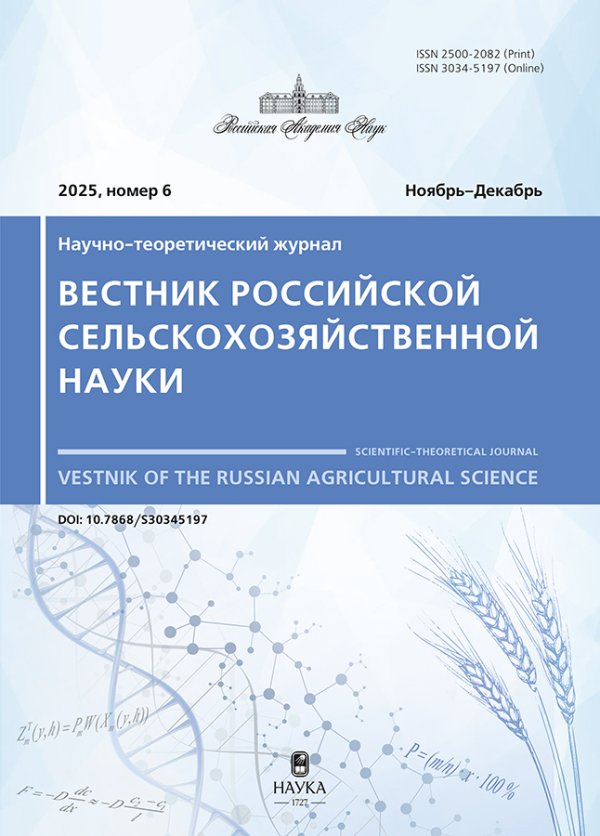Совершенствование процесса криоконсервации спермы крупного рогатого скота молекулярным водородом
- Авторы: Иващенко М.Н.1,2, Дерюгина А.В.1, Белов А.А.1,2, Латушко М.И.3, Игнатьев П.С.3
-
Учреждения:
- ФГАОУ ВО «Национальный исследовательский Нижегородский государственный университет имени Н.И. Лобачевского»
- ФГБОУ ВО «Нижегородский государственный агротехнологический университет имени Л.Я. Флорентьева»
- Производственное объединение «Уральский оптико-механический завод» имени Э.С. Яламова
- Выпуск: № 1 (2025)
- Страницы: 63-66
- Раздел: Зоотехния
- URL: https://ogarev-online.ru/2500-2082/article/view/287067
- DOI: https://doi.org/10.31857/S2500208225010146
- EDN: https://elibrary.ru/CSBCVA
- ID: 287067
Цитировать
Аннотация
Исследовано влияние молекулярного водорода на функциональные показатели сперматозоидов крупного рогатого скота (подвижность, содержание АТФ, окислительные процессы, жизнеспособность, морфология акросомы). Сперму быков черно-пестрой породы разбавляли стерильной средой BioXcell. Для анализа действия молекулярного водорода на сперматозоиды его добавляли в BioXcell. Показатели изучали в нативной сперме, разбавленной средой BioXcell, в сперме после глубокой заморозки, а также в сперме, подвергнутой глубокой заморозке и предварительной обработке молекулярным водородом. Добавление молекулярного водорода в среду для разбавления спермы способствовало росту подвижности клеток, усилению энергетического обмена и снижению оксидативного стресса в сперматозоидах. Доказана необходимость углубленного изучения влияния молекулярного водорода на качественные характеристики сперматозоидов крупного рогатого скота и уточнения на этой основе существующих технологических регламентов консервации семени.
Ключевые слова
Полный текст
Об авторах
Марина Николаевна Иващенко
ФГАОУ ВО «Национальный исследовательский Нижегородский государственный университет имени Н.И. Лобачевского»; ФГБОУ ВО «Нижегородский государственный агротехнологический университет имени Л.Я. Флорентьева»
Автор, ответственный за переписку.
Email: kafedra2577@mail.ru
кандидат биологических наук
Россия, г. Нижний Новгород; г. Нижний НовгородАнна Вячеславовна Дерюгина
ФГАОУ ВО «Национальный исследовательский Нижегородский государственный университет имени Н.И. Лобачевского»
Email: kafedra2577@mail.ru
доктор биологических наук
Россия, г. Нижний НовгородАндрей Александрович Белов
ФГАОУ ВО «Национальный исследовательский Нижегородский государственный университет имени Н.И. Лобачевского»; ФГБОУ ВО «Нижегородский государственный агротехнологический университет имени Л.Я. Флорентьева»
Email: kafedra2577@mail.ru
кандидат биологических наук
Россия, г. Нижний Новгород; г. Нижний НовгородМихаил Иванович Латушко
Производственное объединение «Уральский оптико-механический завод» имени Э.С. Яламова
Email: kafedra2577@mail.ru
кандидат технических наук
Россия, г. ЕкатеринбургПавел Сергеевич Игнатьев
Производственное объединение «Уральский оптико-механический завод» имени Э.С. Яламова
Email: kafedra2577@mail.ru
кандидат физико-математических наук
Россия, г. ЕкатеринбургСписок литературы
- Виноградова И.Л. Метод одновременного определения 2,3 ДФГ и АТФ в эритроцитах // Лабораторное дело. 1980. № 7. С. 424–426.
- Владимиров Ю.А., Арчаков А.И. Перекисное окисление липидов в биологических мембранах. М.: Наука, 1972. 252 с.
- Дерюгина А.В., Иващенко М.Н., Лодяной М.С. Оценка резистентности мембран сперматозоидов быков в процессе долгосрочного хранения // Естественные и технические науки. 2022. Т. 1 (164). С. 107–109.
- Национальная технология замораживания и использования спермы племенных быков-производителей / под ред. А.И. Абилова, Н.М. Решетниковой. М.: 2008. 160 с.
- Пискарев И.М., Иванова И.П., Самоделкин А.Г., Иващенко М.Н. Инициирование и исследование свободно-радикальных процессов в биологических экспериментах. Нижний Новгород, 2016. 106 с.
- Рахманин Ю.А., Егорова Н.А., Михайлова Р.И. Молекулярный водород: биологическое действие, возможности применения в здравоохранении (обзор) // Гигиена и санитария. 2019. Т. 98. № 4. С. 359–365.
- Хышиктуев Б.С., Хышиктуева Н.А., Иванов В.Н. Методы определения продуктов перекисного окисления липидов в конденсате выдыхаемого воздуха и их клиническое значение // Клиническая лабораторная диагностика. 1996. № 3. С. 13–15.
- Aitken R., Gibb Z., Mitchell L. et al. Sperm motility is lost in vitro as a consequence of mitochondrial free radical production and the generation of electrophilic aldehydes but can be significantly rescued by the presence of nucleophilic thiols // Biol Reprod. 2012. V. 87(5). PP. 110. https://doi.org/10.1095/biolreprod. 112.102020
- Bailey J.L., Bilodeau J.F., Cormier N. Semen cryopreservation in domestic animals: a damaging and capacitating phenomenon // J. Androl. 2000. V. 21. PP. 1–7. https://doi.org/10.1002/j.1939-4640.2000.tb03268.x
- Bailey J., Morrier A., Cormier N. Semen cryopreservation: successes and persistent problems in farm species // Can J. Anim Sci. 2003. V. 83. PP. 393–401. https://doi.org/10.4141/A03-024
- Bjelakovic G., Nikolova D., Gluud L. et al. Antioxidant supplements for prevention of mortality in healthy participants and patients with various diseases // Cochrane Database Syst. Rev. 2012. V. 3. CD007176.
- Grötter L.G., Cattaneo L., Estela P. et al. Recent advances in bovine sperm cryopreservation techniques with a focus on sperm post–thaw quality optimization // Reprod Domest Anim. 2019. V. 54. P. 655–665. https://doi.org/10.1111/rda.13409
- Finkel T., Holbrook N. Oxidants, oxidative stress and the biology of ageing // Nature. 2000. V. 408 (6809). PР. 239–247.
- Kimura H. Hydrogen sulfide: from brain to gut // Antioxid. Redox Signal. 2010. V. 12 (9). PР. 1111–1123.
- Kumar A., Prasad J.K., Srivastava N., Ghosh S.K. Strategies to minimize various stress-related freeze–thaw damages during conventional cryopreservation of mammalian spermatozoa // Biopreserv Biobank. 2019. V. 17. P. 603–612. https://doi.org/10.1089/bio.2019.0037
- Liu G.-D., Zhang H., Wang L. Molecular hydrogen regulates the expression of miR-9, miR-21 and miR-199 in LPS-activated retinal microglia cells // Int. J. Ophtalmol. 2013. V. 6. № 3. PР. 280–285.
- McQueen D.B., Zhang J., Robins J.C. Sperm DNA fragmentation and recurrent pregnancy loss: A systematic review and meta-analysis // Fertil. Steril. 2019. № 112. РР. 54–60. https://doi.org/10.1016/j.fertnstert.2019.03.003
- Sato Y., Kajiyama S., Amano A. Hydrogen-rich pure water prevents superoxide formation in brain slices of vitamin C-dependent SMP30/GNL knockout mice // Biochem. Biophys. Res. Commun. 2008. V. 375. № 3. PР. 346–350.
- Smith R., Murphy M. Mitochondria-targeted antioxidants as therapies // Discov. Med. 2011. V. 11 (57). PР. 106–114.
- Ohsawa I., Ishikawa M., Takahashi K. Hydrogen acts as a therapeutic antioxidant by selectively reducing cytotoxic oxygen radicals // Nat. Med. 2007. V. 13. № 6. PР. 688–694.
- Ohta S. Molecular hydrogen as a preventive and therapeutic medical gas: initiation, development and potential of hydrogen medicine // Pharmacol. Ther. 2014. V. 144. № 1. PР. 1–11.
- Xie K., Yu Y., Pei Y., Hou L. Protective effects of hydrogen gas on murine polymicrobal sepsis via reducing oxidative stress and HMGB1 release // Shock. 2010. V. 34. № 1. PР. 90–97.
Дополнительные файлы










